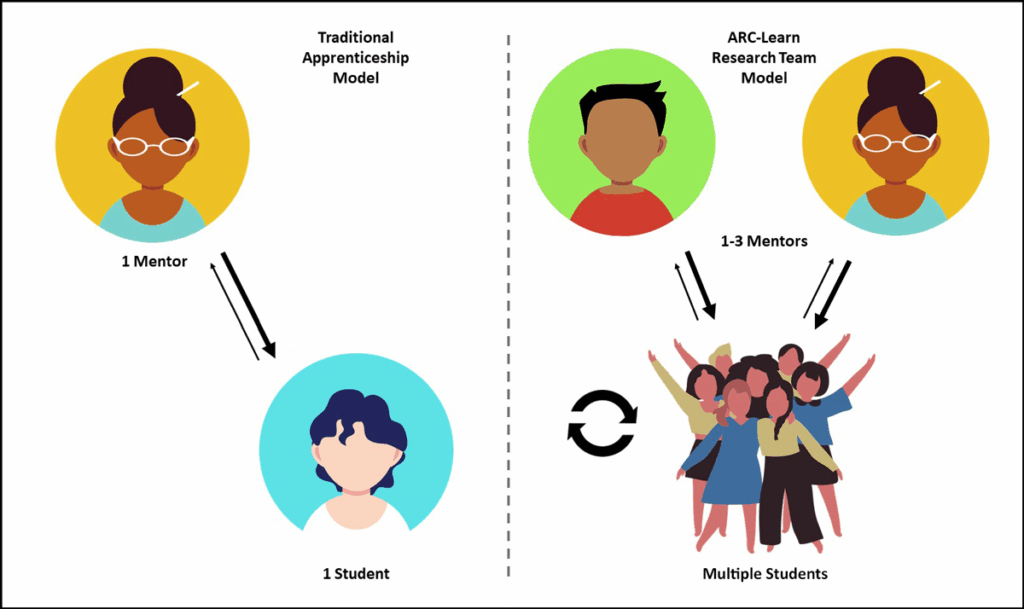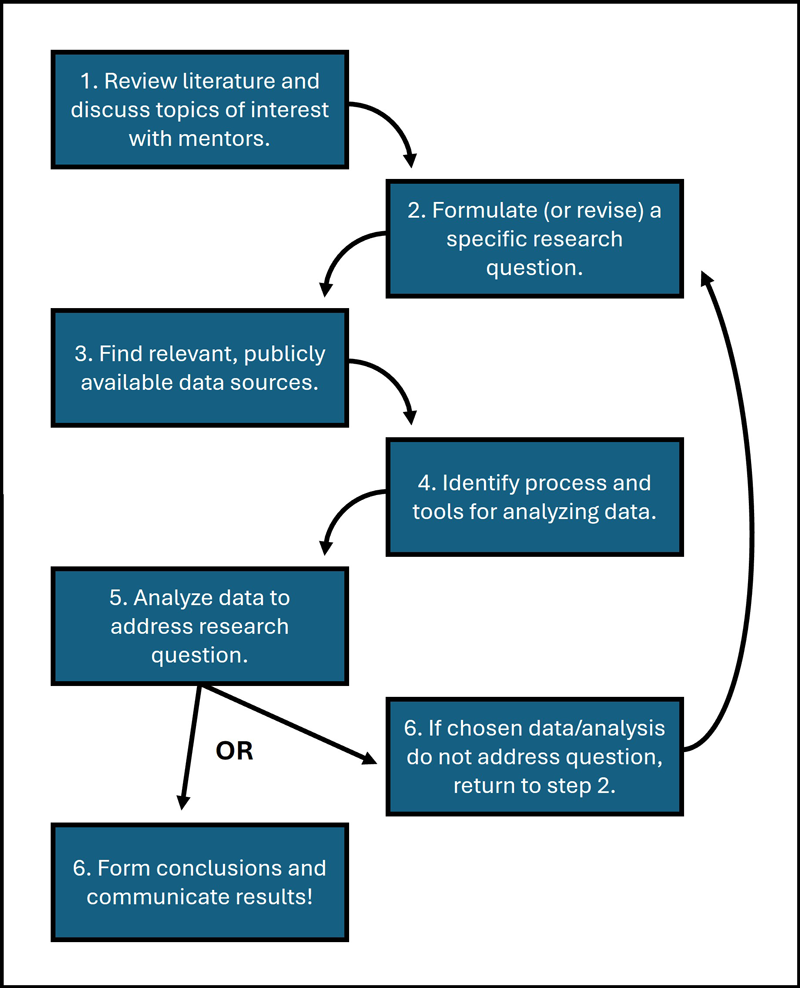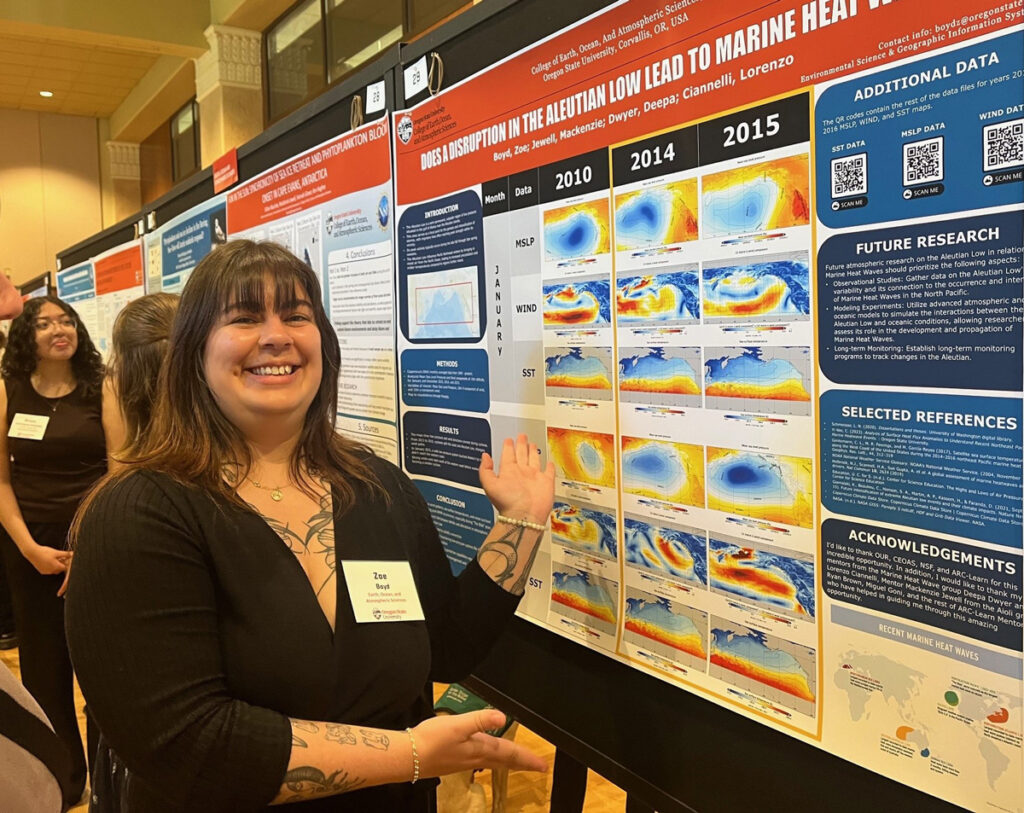Undergraduate research experiences (UREs) in science, technology, engineering, and mathematics (STEM) offer students hands-on research experience and essential professional skills and connections to prepare them to succeed in the workforce. They also cultivate students’ sense of belonging, confidence, and identity—and promote retention—in STEM fields [National Academies of Sciences, Engineering, and Medicine, 2017; Rodenbusch et al., 2016].
To be effective, UREs should be thoughtfully designed to meet the needs of students who may otherwise miss out on career opportunities tied to networking and community-building through such programs. Existing URE programs have followed a range of approaches, but traditionally, many have been centered around short-duration, time-intensive, individual, mentor-directed experiences, such as full-time summer internships in field or laboratory settings. However, these traits can inadvertently exclude some student populations, a concern that is leading many programs to modify their structure and design to engage broader groups.
To lower barriers to participation in UREs, we developed the Authentic Research through Collaborative Learning (ARC-Learn) program at Oregon State University (OSU). ARC-Learn, which ran from 2021 to 2024 and comprised two overlapping student cohorts, offered a long-term, low-intensity program focused on Arctic science and inclusive mentorship. It was designed to help students engage in a science community, foster identities as STEM professionals, and develop critical scientific and data literacy skills and 21st century competencies such as teamwork and communication.
| Table 1. Design Features of ARC-Learn | |
| Feature | Description |
| Duration | 18 months (2 academic years) |
| Intensity | 2–4 hours per week |
| Location | On campus or remote |
| Mentorship | Multiple mentors working in teams with multiple students |
| Topic selection | Student driven |
| Student support | Mentors, peers, program administrators, academic advisors |
| Mentorship development | Inclusive mentorship training, facilitated peer learning community |
| Research tasks | Develop research question, find data and analyze data, draw conclusions, and present findings |
| Student development | Discover own strengths as researchers, work with a team, supplemental training in missing skills |
ARC-Learn incorporated alternative design features (Table 1) to meet the needs of students who do not typically have access to time-intensive field or lab-based UREs, such as transfer students, remote students, and those with dependent care, military service, and other work commitments [Scott et al., 2019] or who have nontraditional enrollment patterns (e.g., dual enrollment in both university and community college, varying enrollment from term to term).
The program was framed in the context of Arctic science because of the region’s outsize effects on climate, ecosystems, and communities globally and to engage students with long-term research investments in polar regions [Marrongelle and Easterling, 2019]. The Arctic also offers a dynamic and interdisciplinary context for a URE program, enabling students to follow their interests in investigating complex science questions. In addition, numerous long-term Arctic monitoring programs offer rich datasets useful in all kinds of STEM careers.
Despite encountering challenges, the ARC-Learn model proved successful at engaging and motivating students and also adaptive as program organizers made adjustments from one cohort to the next in response to participant feedback.
The ARC-Learn Model
With support from mentors and peers, students experienced the whole research arc and gradually took ownership of their work.
Each ARC-Learn cohort lasted 2 academic years and included a dozen or more students. Participants received a stipend to offset costs associated with participation, such as childcare and missed work time, and had the option of obtaining a course credit each term to meet experiential learning requirements. With support from mentors and peers, they experienced the whole research arc and gradually took ownership of their work through three key phases of the program.
Early year 1: Build research teams. Some URE mentorship models involve a mentor primarily driving selection of a research topic and the student completing the work. In ARC-Learn, students learned from multiple mentors and peers, while mentors supported each other and received feedback from students (Figure 1). The students self-selected into research teams focused on a broad topic (e.g., marine heat waves or primary productivity), then developed individual research questions based on their strengths and interests.

Mentor-student teams met every other week—and students met one-on-one with mentors as needed—to support individual projects. The entire cohort also met twice a month to discuss topics including the fundamentals of Arctic science and the scientific process and to report out on progress toward milestones.
Late year 1 to middle of year 2: Develop research questions and find and analyze data. With no field or lab component to the program, ARC-Learn students worked exclusively with existing data. These data came from NASA and NOAA satellite-based sources such as the Moderate Resolution Imaging Spectroradiometer (MODIS), Advanced Very High Resolution Radiometer, and Soil Moisture Active Passive (SMAP) instruments; shipboard sources such as NOAA’s Distributed Biological Observatory, the Alaska Ocean Observing System, and the University-National Oceanographic Laboratory System’s Rolling Deck to Repository; and the National Science Foundation’s (NSF) Arctic Data Center and NOAA’s National Centers for Environmental Information.
Students often revised their research questions or the datasets they used multiple times to produce meaningful findings (Figure 2). Notably, access to these datasets proved critical to the educational experience of ARC-Learn students, highlighting the importance of maintaining them in public archives for future URE activities.

Many students struggled with finding, cleaning, analyzing, and interpreting data, often because of limited experience with tools such as geographic information system software and programming languages such as Python and R. At times, the required expertise was beyond even their mentors’ knowledge. Hands-on skill development workshops during cohort meetings connected students with additional mentors proficient in specific platforms and tools to help fill knowledge gaps and help students overcome obstacles.
Although the students encountered occasional setbacks, they reported that achievements such as settling on a final research question and creating rich data visualizations proved deeply rewarding and motivated further progress.
Late year 2: Share the results. Over several months, students created research posters with feedback and support along the way from their teammates, mentors, and the entire cohort. The program concluded with a grand finale, featuring on-campus gatherings for remote and in-person students, a dress rehearsal poster session, a celebratory dinner, and final presentations at a university-wide undergraduate research symposium.
Zoe’s Story
After a successful 7-year military career, Zoe enrolled at OSU to study the Arctic through her participation in ARC-Learn. As a student in cohort 2, she experienced several challenges along the research arc before finding success, and her experience helps illustrate the program’s model.
Zoe joined fellow students and mentors in the Marine Heatwaves research team and then narrowed her focus by exploring scientific literature and talking with her primary mentor to understand physical and chemical factors associated with marine heat waves as well as their effects on ocean ecosystems. She developed several research questions focused on how factors such as atmospheric pressure and temperature have affected the development and extent of marine heat waves off Alaska since 2010.
As Zoe and her mentor considered available datasets and relevant literature further, they realized that her questions were still too broad given the number of variables affecting ocean-atmosphere interactions. At one of the full-cohort meetings, she shared her difficulties and frustrations, prompting another mentor to offer their help. This mentor worked with Zoe to understand a key meteorological feature—the Aleutian Low—in the area she was studying, as well as relevant data available through the European Union’s Copernicus Climate Change Service [Hersbach et al., 2023] and the appropriate analysis platform.
“We jumped in and learned it together. She helped me find the right data, which in turn, allowed me to finalize my research question,” Zoe said.

From that point, Zoe quickly landed on a focused question that she could address: Does a disruption in the Aleutian Low lead to marine heat waves over the North Pacific region? The final step was to develop a visually striking poster to invite attention, questions, and ideas during the research symposium.
“Seeing other people interested in my research…was validating of me as a scientist.”
Zoe’s experience at the poster session captured what we heard from many other students in the program. Even after her 2 years of being immersed in her project and working with mentors and peers, she said she felt imposter syndrome as a student trying to become a scientist and thought no one would care about her research.
“But people were really interested,” she said. “Seeing other people interested in my research, able to read and understand it on a poster, [and] ask me questions and suggest ideas was validating of me as a scientist.”
A Responsive Approach to URE Design
Through ARC-Learn, program leads sought to expand knowledge about the benefits and challenges of a long-duration, lower-intensity, team-based URE model. Because it was a design-based research program, mentor, student, and coordinator feedback was collected and continually used to make program adjustments [Preston et al., 2022, 2024].
Feedback was collected through pre-, mid-, and end-of-program surveys, as well as pre- and end-of-program interviews, and analyzed by a research and evaluation team. Findings were reported to the program leads, who also met regularly with external expert advisers to get additional recommendations for adjustments. By running two overlapping cohorts (the second started when the first was halfway completed), organizers could address issues that arose for the first cohort to improve the experience of the second one.
Lessons from ARC-Learn are documented in a practitioner guidebook, which discusses practical considerations for others interested in implementing alternative URE models [Brown et al., 2024]. In the guidebook, we examine each design component of ARC-Learn and offer recommendations for designing UREs that meet enrolled students’ specific learning needs and develop their science skills to meet relevant workforce demands.
Novel elements of the Authentic Research through Collaborative Learning (ARC-Learn) program were important in influencing participants’ persistence and success.
A few valuable lessons learned include the following.
Attrition. Expect high attrition rates in UREs designed for nontraditional students, and do not react by making drastic program changes that risk sacrificing otherwise successful program elements. We observed a 45% attrition rate in each cohort, which is indeed high but perhaps not surprising considering the population involved in the program—largely transfer students and those with caregiving or work responsibilities.
Most participants who left did so because of life crises or obligations that paused their research and educational goals. This observation embodies the complexity of students’ lives and reinforces the need for continually creative, flexible, inclusive program structures. For those who completed ARC-Learn, novel elements of the program (e.g., working in teams) were important in influencing their persistence and success.
Remote research applications. The first cohort started in 2021 entirely via remote instruction during the COVID-19 pandemic, before eventually transitioning to a hybrid approach as in-person instruction resumed. All ARC-Learn students in cohort 1 returned to campus, except one Ecampus student, who remained online. The program team and mentors struggled to balance the needs of the remote student, who eventually became somewhat detached from their research team.
As teamwork, camaraderie, and inclusivity are important qualities of the program, we decided for cohort 2 to recruit enough Ecampus students (plus two dedicated mentors) to form a research team of their own. The remote team was engaged and productive—meeting deadlines and producing high-quality work—highlighting the potential of all-remote URE models for students who might otherwise lack access to meaningful research opportunities.
Student-driven research. ARC-Learn empowered students to pursue their own research questions, fostering their autonomy and ownership of their work. However, the open-endedness of selecting their own research paths and the lack of guardrails proved challenging for participants.
We thus hired a program coordinator to provide one-on-one logistical support; establish clear expectations, timelines, and scaffolded assignments; and arrange workshops to teach programming and data analysis skills. This approach, as reported by students who worked with the coordinator, helped many program participants stay on track and ultimately complete their research project.
Mentor coordination. Enabling student success also meant supporting mentors. Organizers provided inclusive mentorship trainings and facilitated a peer learning community. They also made programmatic adjustments in response to experiences in the first cohort.
The student-driven nature of the research sometimes resulted in mismatches between student interests and mentor expertise in cohort 1. So in cohort 2, we engaged mentors earlier in the planning process to define thematic areas for the research teams, creating topics broad enough for students to find an area of interest but narrow enough for mentors to provide guidance. In addition, many mentors had field schedules typical of polar scientists, often resulting in weeks to months at sea. We purposefully paired mentors and asked about planned absences so we could fill any gaps with additional support.
Overall, students in cohort 2 reported feeling highly supported and valued by their mentors and that mentors created welcoming environments to ask questions and solve problems together.
A Foundation to Build On
Participants gained a deep understanding of the complexities and challenges of modern science as well as knowledge and skills needed in scientific education and careers.
From students’ feedback—and the research they did—it’s clear that participants who completed the ARC-Learn program gained a deep understanding of the complexities and challenges of modern science as well as knowledge and skills needed in scientific education and careers. The program thus highlights paths and lessons for others looking to develop successful alternatives to traditional UREs.
Many former ARC-Learn students are continuing to develop research skills, particularly in polar science, through internships and employment in field and lab research efforts. Zoe is working toward a bachelor’s degree in environmental sciences and exploring interests in environmental hazards, conservation, and restoration. For her, the program served as a foundation from which she is building a career and establishing confidence in herself as a scientist.
“I thought I’d have to play catch-up the whole time as an older, nontraditional student,” she said. But through the experience, “I realized I could start anywhere.”
Acknowledgments
ARC-Learn was a collaboration between OSU’s College of Earth, Ocean and Atmospheric Sciences and STEM Research Center. This work is supported by the U.S. NSF (award 2110854). Opinions, findings, conclusions, and recommendations in these materials are those of the authors and do not necessarily reflect the views of NSF.
References
Brown, R., et al. (2024), ARC-Learn Practitioner Guidebook: Practical considerations for implementing an alternative model of undergraduate research experience, Ore. State Univ., Corvallis, https://doi.org/10.5399/osu/1177.
Hersbach, H., et al. (2023), ERA5 monthly averaged data on single levels from 1940 to present, Copernicus Clim. Change Serv. Clim. Data Store, https://doi.org/10.24381/cds.f17050d7.
Marrongelle, K., and W. E. Easterling (2019), Support for engaging students and the public in polar research, Dear Colleague Letter prepared for the U.S. National Science Foundation, Alexandria, Va., www.nsf.gov/funding/opportunities/dcl-support-engaging-students-public-polar-research/nsf19-086.
National Academies of Sciences, Engineering, and Medicine (2017), Undergraduate Research Experiences for STEM Students: Successes, Challenges, and Opportunities, 278 pp., Natl. Acad. Press, Washington, D.C., https://doi.org/10.17226/24622.
Preston, K., J. Risien, and K. B. O’Connell (2022), Authentic Research through Collaborative Learning (ARC-Learn): Undergraduate research experiences in data rich Arctic science formative evaluation report, STEM Res. Cent., Ore. State Univ., Corvallis, https://doi.org/10.5399/osu/1156.
Preston, K., J. Risien, and N. Staus (2024), Authentic Research through Collaborative Learning (ARC-Learn): Undergraduate research experiences in data rich science summative evaluation report, STEM Res. Cent., Ore. State Univ., Corvallis, https://doi.org/10.5399/osu/1178.
Rodenbusch, S. E., et al. (2016), Early engagement in course-based research increases graduation rates and completion of science, engineering, and mathematics degrees, CBE Life Sci. Educ., 15(2), ar20, https://doi.org/10.1187/cbe.16-03-0117.
Scott, G. W., S. Humphries, and D. C. Henri (2019), Expectation, motivation, engagement and ownership: Using student reflections in the conative and affective domains to enhance residential field courses, J. Geogr. Higher Educ., 43(3), 280–298, https://doi.org/10.1080/03098265.2019.1608516.
Author Information
Ryan Brown ([email protected]), Laurie Juranek, and Miguel Goñi, College of Earth, Ocean and Atmospheric Sciences, Oregon State University, Corvallis; and Julie Risien and Kimberley Preston, STEM Research Center, Oregon State University, Corvallis

